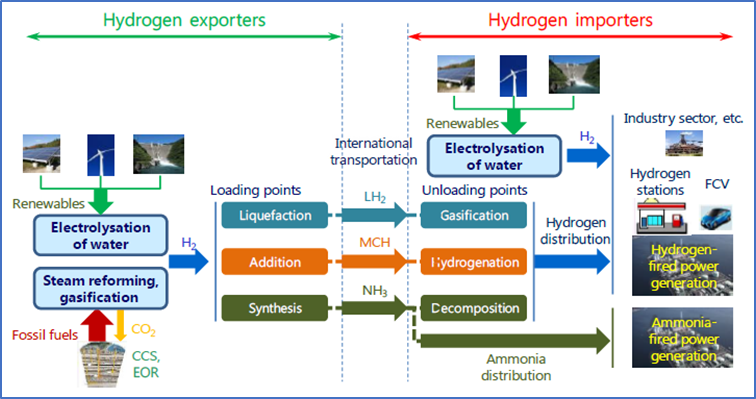The International Association Cedigaz has just released its report “JAPAN HYDROGEN ENERGY IN 2020: THE HYDROGEN SOCIETY IS GRADUALLY COMING TO THE FORE”, which assesses developments and prospects for clean hydrogen in Japan.
THE HYDROGEN SOCIETY IS GRADUALLY COMING TO THE FORE
Japan has been a pioneer in hydrogen and fuel cell technologies and has the world’s most ambitious vision. Japan’s ambition is to lead the way towards decarbonisation in the world by providing hydrogen as a new energy option. In the context of the nation’s unique energy challenges, the government wants to turn Japan into a hydrogen society to solve the issues of energy security and global warming. Japan’s Basic Hydrogen Strategy (2050 Vision) is the world’s first national strategy developed. It describes the future visions for the year 2050 and also serves as an action plan through the year 2030, coordinating public and private hydrogen initiatives. The main thrust of the strategy is to achieve the cost parity of hydrogen with competing fuels (after allowing for environmental externalities) by increasing economies of scale and overcoming technological barriers. The target cost is to make H2 affordable at $3/kgH2 by 2030 and $2/kgH2 by 2050.
Three pillars of the METI’s Basic Hydrogen Strategy:
- To support the development of green hydrogen from local renewable energy sources. The first P2G project (10 MW) was inaugurated in March 2020.
- To exploit low-cost, unused overseas clean hydrogen sources and develop large scale international H2 supply chains. Japan has three energy carriers under demonstration (LH2, MCH, NH3)
- To have a mass usage demand by expanding current uses in buildings, transport and industry, and by introducing hydrogen in power generation. Power capacity based on hydrogen could represent 15-30 GW by 2050 (i.e. 15-30 MtH2)
Key Technologies to be developed
- For production: Electrolysis Systems and Fossil Fuels + CCS
- For Transportation: Energy Carriers (LH2, MCH, NH3)
- For Uses: Fuel Cells for Mobility and Generation, and H2-fired Generation
The International hydrogen supply chains

- Production of hydrogen by gasification of Australian brown coal and transport to Japan under LH2 form.
- Production of hydrogen by electrolysis based on Norwegian renewable power and transport to Japan under LH2 form.
- Production of hydrogen by steam reforming based on Brunei natural gas, its conversion into MCH, transport to Japan, and extraction of hydrogen from MCH in Japan.
- Production of hydrogen by electrolysis based on New Zealand geothermal power and its conversion into MCH for transport to Japan.
- Production of clean ammonia from Saudi Arabia’s associated natural gas and its transport to Japan.
- Production of clean ammonia from Australia (produced from natural gas and renewables), its transport to Japan and its use in power generation (feasibility studies launched in March and May 2020).
By Sylvie Cornot-Gandolphe for CEDIGAZ
